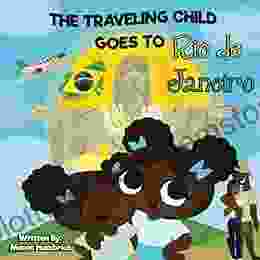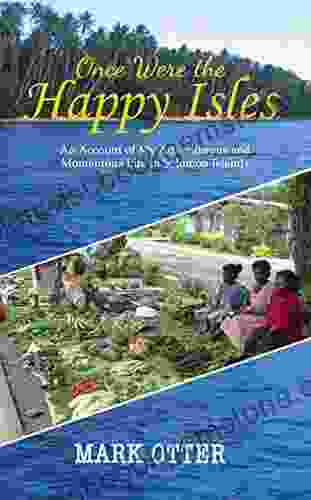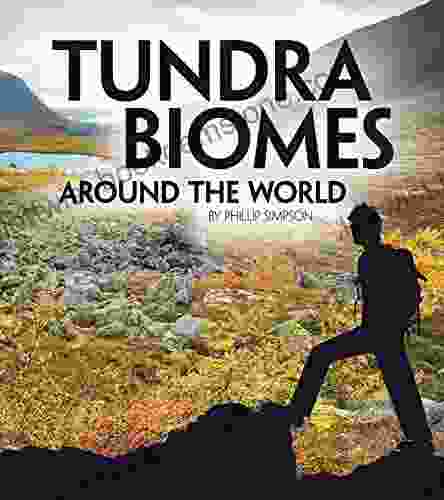Tundra Biomes Around the World: Exploring Earth's Frozen Frontiers

Tundra biomes are vast, treeless regions located in the far northern and southern latitudes of the Earth. These icy environments are characterized by permanently frozen soil, known as permafrost, and a harsh climate with extreme temperatures, limited precipitation, and short growing seasons. Despite their inhospitable conditions, tundra biomes support a rich and unique array of life, from hardy plants to specialized animals.
In this article, we will delve into the intriguing characteristics of tundra biomes around the world. We will explore their diverse landscapes, examine their unique wildlife and vegetation, and highlight their ecological significance. By understanding these frozen frontiers, we gain a deeper appreciation for the interconnectedness and resilience of Earth's ecosystems.
5 out of 5
| Language | : | English |
| File size | : | 19861 KB |
| Screen Reader | : | Supported |
| Print length | : | 32 pages |
Types of Tundra Biomes
There are two primary types of tundra biomes:
- Arctic Tundra: Located in the northernmost regions of the world, including Alaska, Canada, Russia, and Greenland, the Arctic tundra is characterized by extreme cold and a long winter season. The average temperature during the coldest month is below -30°C (-22°F),and the growing season lasts for only a few weeks during the summer.
- Antarctic Tundra: Found on the continent of Antarctica, the Antarctic tundra is even colder and more desolate than the Arctic tundra. The average temperature year-round is below freezing, and the growing season is virtually nonexistent. The Antarctic tundra is also home to the largest ice sheet on Earth, which covers almost the entire continent.
Characteristics of Tundra Biomes
Tundra biomes are defined by several key characteristics:
- Permafrost: Permafrost is a layer of soil that remains frozen throughout the year, even during the summer months. Permafrost prevents water drainage and can create unique features such as pingos (conical hills) and thermokarsts (depressions).
- Short Growing Seasons: Tundra biomes have very short growing seasons due to the extreme cold and low precipitation. Plants have adapted to these conditions by developing fast-growing strategies and storing nutrients underground.
- Low Precipitation: Tundra biomes receive very little precipitation, typically less than 250 mm (10 inches) per year. This limited precipitation can make it difficult for plants and animals to survive.
- Harsh Climate: Tundra biomes experience extreme temperature fluctuations, with winter temperatures dropping below -50°C (-58°F) and summer temperatures rarely exceeding 15°C (59°F). Strong winds and blizzards are also common.
- Treeless Landscape: Tundra biomes are treeless due to the cold temperatures and permafrost. Trees cannot survive in these conditions, and the vegetation is dominated by low-growing shrubs, mosses, and lichens.
Wildlife of Tundra Biomes
Despite their harsh conditions, tundra biomes support a diverse array of wildlife adapted to their cold and icy environment.
- Mammals: Tundra biomes are home to a variety of mammals, including reindeer, caribou, musk oxen, polar bears, wolves, and Arctic foxes. These animals have thick fur and a thick layer of body fat to protect them from the extreme cold.
- Birds: Tundra biomes are also a breeding ground for migratory birds. During the summer months, hundreds of bird species migrate to the tundra to take advantage of the abundance of food and breeding grounds.
- Fish: Arctic tundra biomes support a variety of fish species, including Arctic char, whitefish, and salmon. These fish have adapted to the cold water temperatures and can survive in the shallow, frozen lakes and rivers.
- Invertebrates: Tundra biomes are home to a variety of invertebrates, such as insects, spiders, and worms. These invertebrates play an important role in the food chain by providing food for larger animals.
Vegetation of Tundra Biomes
Although tundra biomes are treeless, they do support a variety of low-growing vegetation.
- Mosses and Lichens: Mosses and lichens are the most common plants in tundra biomes. They are able to survive in the cold, dry conditions and can form dense mats that cover the ground.
- Shrubs: Some shrubs, such as willows, birches, and ericaceous shrubs, are also found in tundra biomes. These shrubs typically grow close to the ground to protect themselves from the wind and cold.
- Grasses and Sedges: Grasses and sedges are also found in tundra biomes, but they are typically short and have narrow leaves to reduce exposure to the cold.
Ecological Importance of Tundra Biomes
Tundra biomes play an important ecological role in the global ecosystem.
- Carbon Storage: Tundra biomes store a significant amount of carbon in their permafrost and vegetation. This carbon is released into the atmosphere when the permafrost thaws, which can have significant implications for the global climate.
- Water Cycling: Tundra biomes play an important role in the water cycle. The frozen ground prevents water from draining away, and the snow and ice meltwater can provide a significant source of water for downstream ecosystems.
- Habitat for Wildlife: Tundra biomes provide a unique habitat for a variety of wildlife. The cold temperatures and short growing seasons can be challenging for some animals, but many have adapted to the harsh conditions and rely on the tundra for their survival.
- Climate Regulation: Tundra biomes play a role in climate regulation. The white snow and ice reflect sunlight back into space, which helps to cool the Earth. Additionally, the permafrost acts as a heat sink, absorbing heat from the atmosphere during the summer and releasing it back during the winter.
- Cultural Significance: Tundra biomes are home to many indigenous peoples, for whom these regions have cultural and spiritual significance. These people rely on the tundra for hunting, fishing, and other traditional practices.
Tundra biomes are fascinating and fragile ecosystems that play a vital role in the global ecology. Despite their harsh conditions, they support a diverse array of life and provide a valuable insight into the adaptations and resilience of species. As we continue to learn more about these frozen frontiers, we gain a deeper understanding of the interconnectedness of Earth's ecosystems and the importance of protecting them.
5 out of 5
| Language | : | English |
| File size | : | 19861 KB |
| Screen Reader | : | Supported |
| Print length | : | 32 pages |
Do you want to contribute by writing guest posts on this blog?
Please contact us and send us a resume of previous articles that you have written.
 Best Book
Best Book Page Flip
Page Flip Bookshelf
Bookshelf Literary loom
Literary loom Chapter
Chapter Bookish
Bookish PageTurner
PageTurner Bibliophile
Bibliophile Story
Story Inkwell
Inkwell Bookworm
Bookworm Labyrinth
Labyrinth Plot Twist
Plot Twist Prose
Prose Paperback
Paperback Storyteller
Storyteller Sanctuary
Sanctuary Fiction
Fiction Reading
Reading Chronicle
Chronicle Read
Read Patricia Gavin
Patricia Gavin Robert Hughes
Robert Hughes Parshwika Bhandari
Parshwika Bhandari Christopher Hitchens
Christopher Hitchens Isao Honda
Isao Honda Clarissa Mcnair
Clarissa Mcnair Linda Legarde Grover
Linda Legarde Grover Laura Stanton
Laura Stanton Levi Werner
Levi Werner Tracey Clapp
Tracey Clapp Scott Pelley
Scott Pelley Jessica Holmes
Jessica Holmes Mzsassytheauthor
Mzsassytheauthor Jenna Rainey
Jenna Rainey Daphne Hicks
Daphne Hicks Christine Schmidt
Christine Schmidt Uma Kelkar
Uma Kelkar Ariana Godoy
Ariana Godoy Geoffrey Jones
Geoffrey Jones P R Adams
P R Adams Guido Sperandio
Guido Sperandio J P Wearing
J P Wearing Nick Dawson
Nick Dawson Gabriella De Ferrari
Gabriella De Ferrari Darryl Benally
Darryl Benally Patrick Suskind
Patrick Suskind David Koenig
David Koenig Greg Smrdel
Greg Smrdel H Eugene Bradford
H Eugene Bradford Jonathan Lyons
Jonathan Lyons Karen Mccartney
Karen Mccartney Ciara Cole
Ciara Cole Thomas Hollowell
Thomas Hollowell Kenneth Bain
Kenneth Bain Maggie Kate
Maggie Kate Charles E Gannon
Charles E Gannon Erhard Klepper
Erhard Klepper Sarah Cords
Sarah Cords Katlynn Brooke
Katlynn Brooke Chris Wraight
Chris Wraight John Stevens
John Stevens Sam Harrison
Sam Harrison Stephanie Dray
Stephanie Dray Dk Eyewitness
Dk Eyewitness Claire M L Bourne
Claire M L Bourne Diahann Carroll
Diahann Carroll Charles John Cutcliffe Wright Hyne
Charles John Cutcliffe Wright Hyne Matt Fox
Matt Fox Daniel Keyes
Daniel Keyes Chris Glover
Chris Glover Yuri Leving
Yuri Leving Chris Gardner
Chris Gardner Cia Sautter
Cia Sautter Kate Kozma
Kate Kozma Tamima Bayhom Daou
Tamima Bayhom Daou Ellen Datlow
Ellen Datlow Charles Cahier
Charles Cahier Joan Vassar
Joan Vassar Michael Anderle
Michael Anderle Yatir Nitzany
Yatir Nitzany David L Sloan
David L Sloan Jean Haines
Jean Haines Stuart Ross
Stuart Ross Lannah Sawers Diggins
Lannah Sawers Diggins Kenneth Conibear
Kenneth Conibear Chris Forsey
Chris Forsey Penelope Myrtle Kelsey
Penelope Myrtle Kelsey David Archer
David Archer Juilene Osborne Mcknight
Juilene Osborne Mcknight Gustavo Arellano
Gustavo Arellano Karl Taro Greenfeld
Karl Taro Greenfeld Susie Hodge
Susie Hodge Beth Tondreau
Beth Tondreau El Ghalia Magazine
El Ghalia Magazine Jack Mcdevitt
Jack Mcdevitt Tameichi Hara
Tameichi Hara Robert Rath
Robert Rath Chris Martin
Chris Martin Chan
Chan Clayton M Rines
Clayton M Rines Robert Louis Stevenson
Robert Louis Stevenson Mike Gagnon
Mike Gagnon Chuck Lukacs
Chuck Lukacs Stacy Schiff
Stacy Schiff Patrick O Sullivan
Patrick O Sullivan Clara Silverstein
Clara Silverstein Erin Bomboy
Erin Bomboy Danielle Evans
Danielle Evans Louise Fili
Louise Fili Nell Irvin Painter
Nell Irvin Painter Shirley Adams
Shirley Adams Tom Brierton
Tom Brierton Greg Manning
Greg Manning Jay Artale
Jay Artale Kasey Martin
Kasey Martin Cherish Amore
Cherish Amore Francis M Higman
Francis M Higman Helen Dunn Frame
Helen Dunn Frame Chavoret Jaruboon
Chavoret Jaruboon Robert Warren
Robert Warren Tina Sutton
Tina Sutton Charmaine Ross
Charmaine Ross Celeste Granger
Celeste Granger Ken Lozito
Ken Lozito Howard Ball
Howard Ball Lamont Lindstrom
Lamont Lindstrom Judith Reeves Stevens
Judith Reeves Stevens Federico Vinciolo
Federico Vinciolo Marcus Lewis
Marcus Lewis Cheryl Pallant
Cheryl Pallant Patti Delano
Patti Delano Ella Blake
Ella Blake Claudia Nice
Claudia Nice James M Dunlop
James M Dunlop Jason Smart
Jason Smart Chris Derochie
Chris Derochie C Gockel
C Gockel K A Albury
K A Albury Gail Desberg
Gail Desberg Dr Christopher Heath Brown
Dr Christopher Heath Brown Ceidrik Heward
Ceidrik Heward Celeste Ng
Celeste Ng Greg Young
Greg Young Stan C Smith
Stan C Smith Naomi Raquel Enright
Naomi Raquel Enright Graham Mackintosh
Graham Mackintosh Danyel Smith
Danyel Smith Nick Haskins
Nick Haskins Kay Walten
Kay Walten Tara L Thompson
Tara L Thompson Maria Coffey
Maria Coffey Ian Roberts
Ian Roberts Ron Reeder
Ron Reeder Tony Walsh
Tony Walsh Charles N Li
Charles N Li Pauline Baer De Perignon
Pauline Baer De Perignon Talek Nantes
Talek Nantes Patricia Weiss Levy
Patricia Weiss Levy Richard Kadrey
Richard Kadrey Kate Brideau
Kate Brideau Elizabeth Nyamayaro
Elizabeth Nyamayaro James Morrow
James Morrow Charles Neider
Charles Neider David Mcmillan
David Mcmillan Kareem Abdul Jabbar
Kareem Abdul Jabbar Katie Booth
Katie Booth Judy Temes
Judy Temes Jessica N Watkins
Jessica N Watkins Myron Howard Nadel
Myron Howard Nadel Tristan Jones
Tristan Jones John Dougill
John Dougill David Perlmutter
David Perlmutter J A Jernay
J A Jernay Brendan Keogh
Brendan Keogh Spencer Sekyer
Spencer Sekyer J Torres
J Torres Claudia La Malfa
Claudia La Malfa Edita A Petrick
Edita A Petrick Michael Warr
Michael Warr Christopher Hart
Christopher Hart Byron L Dorgan
Byron L Dorgan Eden Redd
Eden Redd Tanav Patkar
Tanav Patkar Patti Brady
Patti Brady Damon Young
Damon Young David Kadavy
David Kadavy Cheryl Probst
Cheryl Probst Paul Sahre
Paul Sahre David Zwick
David Zwick Tasha Schuh
Tasha Schuh Nicholas Sammond
Nicholas Sammond Harlan Coben
Harlan Coben Helen Wenley
Helen Wenley Rick Furphy
Rick Furphy Monet Hambrick
Monet Hambrick Dan Abnett
Dan Abnett Persi Diaconis
Persi Diaconis Elliott J Gorn
Elliott J Gorn Catherine Clinton
Catherine Clinton K Patrick Donoghue
K Patrick Donoghue Gayle Roehm
Gayle Roehm Christopher De Hamel
Christopher De Hamel Steven Moffat
Steven Moffat Cheryl Wills
Cheryl Wills James Joe Arce Espinoza
James Joe Arce Espinoza Megan Carr
Megan Carr Marian Jazmik
Marian Jazmik Steven Cronin
Steven Cronin Jaycee Lee Dugard
Jaycee Lee Dugard Joanna Henly
Joanna Henly Christina Lauren
Christina Lauren Charlotte Cotton
Charlotte Cotton Sherryl Woods
Sherryl Woods Wayne Van Zyl
Wayne Van Zyl Paul Austin Ardoin
Paul Austin Ardoin Edward Dolnick
Edward Dolnick Robert H Mohlenbrock
Robert H Mohlenbrock J Edward Cornelius
J Edward Cornelius Paolo Cognetti
Paolo Cognetti Jez Stewart
Jez Stewart Chasta Hamilton
Chasta Hamilton Eric Franklin
Eric Franklin Erica Armstrong Dunbar
Erica Armstrong Dunbar Paul Dryburgh
Paul Dryburgh Laura Schroff
Laura Schroff Mia Sosa
Mia Sosa Charlotte Amelia Poe
Charlotte Amelia Poe David Lee Corley
David Lee Corley Chris Santella
Chris Santella Dj Davin
Dj Davin Martin Olson
Martin Olson Christian Cashelle
Christian Cashelle Clara Claiborne Park
Clara Claiborne Park William G Krejci
William G Krejci Glenn Lovell
Glenn Lovell Paul Waddington
Paul Waddington Melissa Gould
Melissa Gould Victor Lavalle
Victor Lavalle Marc Hendrickx
Marc Hendrickx Cynthia Helms
Cynthia Helms Cecilia Aragon
Cecilia Aragon Cherie Burns
Cherie Burns Charlie English
Charlie English Christiane Paul
Christiane Paul Elizabeth Vargas
Elizabeth Vargas Chris Wilson
Chris Wilson Ruth Grace David
Ruth Grace David Martin J Smith
Martin J Smith Christopher Busta Peck
Christopher Busta Peck William Bligh
William Bligh Celia Espelleta
Celia Espelleta Cicely Berry
Cicely Berry Cixin Liu
Cixin Liu Christina C Jones
Christina C Jones Cj Hernley
Cj Hernley Roger Fawcett Tang
Roger Fawcett Tang Christopher J Earnshaw
Christopher J Earnshaw Vince Flynn
Vince Flynn Paul Morand
Paul Morand Cecil King
Cecil King Jason Wilson
Jason Wilson Rabia Chaudry
Rabia Chaudry Richard Kostelanetz
Richard Kostelanetz Gavin Francis
Gavin Francis Victoria Twead
Victoria Twead Claire Chao
Claire Chao Trevor Herriot
Trevor Herriot Neda Toloui Semnani
Neda Toloui Semnani Colette Livermore
Colette Livermore David James
David James David Weaver
David Weaver Yuki Shimada
Yuki Shimada Joshua Sperling
Joshua Sperling Gareth Kershaw
Gareth Kershaw Nikki Solano
Nikki Solano Juno Dawson
Juno Dawson Jeanette Winterson
Jeanette Winterson Michelle Heffner Hayes
Michelle Heffner Hayes Janet Bishop
Janet Bishop Sean Robins
Sean Robins Katherine Davidsen
Katherine Davidsen Pamela Des Barres
Pamela Des Barres Christine Feehan
Christine Feehan Katie Piper
Katie Piper Jim Mccarthy
Jim Mccarthy Jeff Somers
Jeff Somers E L Strife
E L Strife Daniel J Boorstin
Daniel J Boorstin Chris Tatted Strength Luera
Chris Tatted Strength Luera Jackie Parry
Jackie Parry Cathy Johnson
Cathy Johnson Don Moore
Don Moore Charles Warren Stoddard
Charles Warren Stoddard Ursula Burns
Ursula Burns Zlatan Ibrahimovic
Zlatan Ibrahimovic Laura Mckowen
Laura Mckowen Charles Greacen
Charles Greacen Murisa Harba
Murisa Harba Helen Greathead
Helen Greathead Gem Barton
Gem Barton Cecilie Okada
Cecilie Okada Rosalie Knecht
Rosalie Knecht Cosimo Yap
Cosimo Yap Charmaine Pauls
Charmaine Pauls Julie Gregory
Julie Gregory Laurell K Hamilton
Laurell K Hamilton Kanoe Kaye
Kanoe Kaye Teresa Marrone
Teresa Marrone Seymour Topping
Seymour Topping John Burrowes
John Burrowes M P Verneuil
M P Verneuil Fodor S Travel Guides
Fodor S Travel Guides George Orwell
George Orwell Tom Gasek
Tom Gasek Charlaine Harris
Charlaine Harris Oksana Marafioti
Oksana Marafioti Thomas Cahill
Thomas Cahill Jamie Markle
Jamie Markle Steve Inskeep
Steve Inskeep Steve Mcnaughton
Steve Mcnaughton Jeff Frazier
Jeff Frazier Chinelo Bally
Chinelo Bally John Ringo
John Ringo Richard Rand
Richard Rand Jonh Craft
Jonh Craft Jeff Finley
Jeff Finley Henry Louis Gates Jr
Henry Louis Gates Jr Chuck Palahniuk
Chuck Palahniuk Robin Hemley
Robin Hemley Joe Greer
Joe Greer Daniel V Runyon
Daniel V Runyon Clay Boutwell
Clay Boutwell Kimberly Elam
Kimberly Elam Kostya Kennedy
Kostya Kennedy Joanna Elisabeth Jones
Joanna Elisabeth Jones Susan Frohlick
Susan Frohlick Janna L Goodwin
Janna L Goodwin Jeremy Scott
Jeremy Scott Panos Kompatsiaris
Panos Kompatsiaris Kai Harris
Kai Harris Christopher Hull
Christopher Hull Matthew O Duncan
Matthew O Duncan Tim Pond
Tim Pond Chris Haft
Chris Haft Christopher Howard
Christopher Howard Jeremy Robinson
Jeremy Robinson Jenni Reavis
Jenni Reavis Chris Kennedy
Chris Kennedy Mark Bergin
Mark Bergin Simple Language Learning
Simple Language Learning Ralph H Nutter
Ralph H Nutter Soyeung Koh
Soyeung Koh Mia Kang
Mia Kang Christina Asquith
Christina Asquith Nicholas Sparks
Nicholas Sparks Daniel C Matt
Daniel C Matt Olaudah Equiano
Olaudah Equiano Orange Hippo
Orange Hippo Dexter Lives
Dexter Lives Victor Silvester
Victor Silvester Olivia Drake
Olivia Drake Lyssa Kay Adams
Lyssa Kay Adams Grantlee Kieza
Grantlee Kieza Christian Kallias
Christian Kallias John G Hemry
John G Hemry Don George
Don George Dan Tirels
Dan Tirels John Higgs
John Higgs Gilad Segev
Gilad Segev Johnny Molloy
Johnny Molloy Patricia Coenjaerts
Patricia Coenjaerts Christopher Coates
Christopher Coates John Megre Shields
John Megre Shields Ronen Rybner
Ronen Rybner Jan Wong
Jan Wong Philip Hook
Philip Hook Robin Bayley
Robin Bayley Richard Erdoes
Richard Erdoes Lisa Hobman
Lisa Hobman Sharon F Patton
Sharon F Patton Walidah Imarisha
Walidah Imarisha Lindsay Williams
Lindsay Williams Nicole Porter Ekdahl
Nicole Porter Ekdahl Karpov Kinrade
Karpov Kinrade Trevor Waugh
Trevor Waugh T Patrick Mcgonegle
T Patrick Mcgonegle Charles Stross
Charles Stross Eleanor Brown
Eleanor Brown Elizabeth Lunday
Elizabeth Lunday Margaret Radcliffe
Margaret Radcliffe T Kira Madden
T Kira Madden Christopher P Lehman
Christopher P Lehman Chuy Renteria
Chuy Renteria John Richard Stephens
John Richard Stephens Sean Adams
Sean Adams Nicoli Gonnella
Nicoli Gonnella Tom Bergeron
Tom Bergeron Michelle Space
Michelle Space Peter Morgan
Peter Morgan Norman Spinrad
Norman Spinrad Bill Markley
Bill Markley Pixie Unger
Pixie Unger Marjan Kamali
Marjan Kamali Dem Mikhailov
Dem Mikhailov Jordan Goodman
Jordan Goodman Sarah Moss
Sarah Moss Huw Lewis Jones
Huw Lewis Jones Christopher Butler
Christopher Butler James Oliver Curwood
James Oliver Curwood Charles Dickens
Charles Dickens Dr Constance Mcintyre
Dr Constance Mcintyre Clarence Boulay
Clarence Boulay Chris Welles Feder
Chris Welles Feder Chelsea Ward
Chelsea Ward Kay Doherty Bennett
Kay Doherty Bennett Nicholas Taylor
Nicholas Taylor Joann Bassett
Joann Bassett Chloe Garner
Chloe Garner Heather Webber
Heather Webber Felicia P Roche
Felicia P Roche Philippe Lhez
Philippe Lhez Charlie Porter
Charlie Porter Michael Arditti
Michael Arditti Kevin Crossley
Kevin Crossley Susan H Gray
Susan H Gray Charles Nicholl
Charles Nicholl Claude C Hopkins
Claude C Hopkins John Steinbreder
John Steinbreder Cheryl R Shrock
Cheryl R Shrock Jon Amtrup
Jon Amtrup Queen T
Queen T Chris Mcdonnell
Chris Mcdonnell Terry Mixon
Terry Mixon Robert Kurson
Robert Kurson James Abbott Mcneill Whistler
James Abbott Mcneill Whistler Megan Nicolay
Megan Nicolay Clarence King
Clarence King Paul Bellow
Paul Bellow Christine Williams
Christine Williams Paul Lagreca
Paul Lagreca Cheri Shanti
Cheri Shanti Claire Wilcox
Claire Wilcox Stephen Graham
Stephen Graham Walter Rankin
Walter Rankin Frank Langfitt
Frank Langfitt Colin Powell
Colin Powell Charlotte Mullins
Charlotte Mullins Charles Dellheim
Charles Dellheim Weike Wang
Weike Wang Werner Herzog
Werner Herzog Michael Newberry
Michael Newberry Julian Bound
Julian Bound Chris Mcmorran
Chris Mcmorran Chimamanda Ngozi Adichie
Chimamanda Ngozi Adichie Carol Bolt
Carol Bolt Joseph Richard Werne
Joseph Richard Werne James Clarke
James Clarke Jeffery Deaver
Jeffery Deaver Christina Courtenay
Christina Courtenay Cheryl Briggs
Cheryl Briggs Ciena Foxx
Ciena Foxx Charles Soule
Charles Soule Charissa N Terranova
Charissa N Terranova David Ritz
David Ritz Dr Habib Siddiqui
Dr Habib Siddiqui William Silvers
William Silvers Chris Pallant
Chris Pallant Chris Frost
Chris Frost Sue Burke
Sue Burke Sally Hull
Sally Hull Kim Barker
Kim Barker Richard Glazier
Richard Glazier Loki Renard
Loki Renard Charles Dana Gibson
Charles Dana Gibson Christina Zierold
Christina Zierold Clara Kramer
Clara Kramer Greg Bear
Greg Bear Steven Skaggs
Steven Skaggs Olan Thorensen
Olan Thorensen Melissa R Kerin
Melissa R Kerin John F Callahan
John F Callahan John M Perkins
John M Perkins Nick Paparone
Nick Paparone Mikesha Fuller
Mikesha Fuller Justin D Hill
Justin D Hill Cynthia Brideson
Cynthia Brideson Daniel Colter
Daniel Colter Kevin A Codd
Kevin A Codd Kwasu David Tembo
Kwasu David Tembo Henry Porter
Henry Porter Isa Down
Isa Down Nicky Earwaker
Nicky Earwaker Ellen Lupton
Ellen Lupton Richard J Powell
Richard J Powell Christopher Reeve
Christopher Reeve Steve Biddle
Steve Biddle Brenda Mohammed
Brenda Mohammed Janet Evanovich
Janet Evanovich Jackie Isard
Jackie Isard Michael Atamanov
Michael Atamanov Eleanor Winters
Eleanor Winters Stuart Woods
Stuart Woods David Housewright
David Housewright Walter Tevis
Walter Tevis Christoph Niemann
Christoph Niemann Victoria Buitron
Victoria Buitron Martin Wainwright
Martin Wainwright Ricky Tims
Ricky Tims Simon Doonan
Simon Doonan Jim Kristofic
Jim Kristofic Jason Krumbine
Jason Krumbine Marcy Ferro
Marcy Ferro Ken Liu
Ken Liu Cathy Lynn Brooks
Cathy Lynn Brooks Lauren Hom
Lauren Hom Francesco Lo Iacono
Francesco Lo Iacono Gina Lee Kim
Gina Lee Kim Charles H Dyer
Charles H Dyer Victor Davis Hanson
Victor Davis Hanson Claude Brown
Claude Brown Chris Harrison
Chris Harrison James Spooner
James Spooner Leslie S Klinger
Leslie S Klinger Robin Ratchford
Robin Ratchford Charles Yu
Charles Yu Jerome K Jerome
Jerome K Jerome Deborah Vadas Levison
Deborah Vadas Levison Nicholas Coleridge
Nicholas Coleridge Kal Penn
Kal Penn Donna Williams
Donna Williams Chris Enss
Chris Enss Iain Stewart
Iain Stewart Robin Cormack
Robin Cormack Stacy Thomas
Stacy Thomas Susan Owens
Susan Owens India T Norfleet
India T Norfleet Charles Moore
Charles Moore Raymond E Feist
Raymond E Feist Linda Holmes
Linda Holmes Chip Kidd
Chip Kidd Erasmo Acosta
Erasmo Acosta James Gracey
James Gracey Chris Gabbard
Chris Gabbard Laura Perryman
Laura Perryman Vicki Mcmurry
Vicki Mcmurry Colin Valentine
Colin Valentine Michael Williams
Michael Williams Morgan Rice
Morgan Rice Rosa Say
Rosa Say Sarah Thornton
Sarah Thornton Joshua Samuel Brown
Joshua Samuel Brown Eric Seale
Eric Seale Miles Martin
Miles Martin Ellen Warren
Ellen Warren Cholly Atkins
Cholly Atkins Edmund De Waal
Edmund De Waal Not For Tourists
Not For Tourists
Light bulbAdvertise smarter! Our strategic ad space ensures maximum exposure. Reserve your spot today!

 Eddie PowellThe Traveling Child Goes to Rio de Janeiro: An Unforgettable Adventure to the...
Eddie PowellThe Traveling Child Goes to Rio de Janeiro: An Unforgettable Adventure to the... James HayesFollow ·18.6k
James HayesFollow ·18.6k Finn CoxFollow ·9.5k
Finn CoxFollow ·9.5k Cristian CoxFollow ·9.8k
Cristian CoxFollow ·9.8k Guy PowellFollow ·7.2k
Guy PowellFollow ·7.2k Russell MitchellFollow ·17.8k
Russell MitchellFollow ·17.8k William ShakespeareFollow ·9.4k
William ShakespeareFollow ·9.4k Brenton CoxFollow ·8.6k
Brenton CoxFollow ·8.6k Branson CarterFollow ·18.4k
Branson CarterFollow ·18.4k

 John Grisham
John GrishamTravel Enlightens: Four Brief Essays
Essay 1: Travel as a Window to the...

 Dominic Simmons
Dominic SimmonsCricut Design Space for Beginners: A Comprehensive Guide...
Cricut Design Space...

 Carson Blair
Carson BlairFairy Tale Archetypes in Eight Horror and Suspense Films:...
Fairy tales, with their...

 Wade Cox
Wade CoxThe Complete Diving Guide To Sint Eustatius
Sint Eustatius is a...

 Curtis Stewart
Curtis StewartOnce Were the Happy Isles
A Journey Through the Heart...
5 out of 5
| Language | : | English |
| File size | : | 19861 KB |
| Screen Reader | : | Supported |
| Print length | : | 32 pages |












